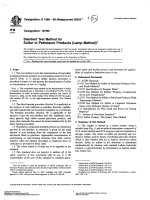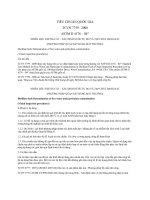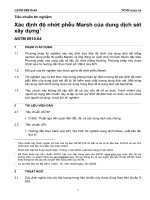Astm d 1306 88 (1996)e1
Bạn đang xem bản rút gọn của tài liệu. Xem và tải ngay bản đầy đủ của tài liệu tại đây (37.17 KB, 2 trang )
Designation: D 1306 – 88 (Reapproved 1996)e1
AMERICAN SOCIETY FOR TESTING AND MATERIALS
100 Barr Harbor Dr., West Conshohocken, PA 19428
Reprinted from the Annual Book of ASTM Standards. Copyright ASTM
Standard Test Method for
Phthalic Anhydride Content of Alkyd Resins and Esters
Containing Other Dibasic Acids (Gravimetric)1
This standard is issued under the fixed designation D 1306; the number immediately following the designation indicates the year of
original adoption or, in the case of revision, the year of last revision. A number in parentheses indicates the year of last reapproval. A
superscript epsilon (e) indicates an editorial change since the last revision or reapproval.
This standard has been approved for use by agencies of the Department of Defense.
e1 NOTE—Keywords were added editorially in October 1996.
fitted with an air-cooled glass reflux condenser 30 in. (760 mm)
in length. The connection between the flask and condenser
shall be a standard-taper 24/40 ground-glass joint.
5.2 Water Bath.
5.3 Guard Tube, filled with soda lime.
5.4 Fritted-Glass Filter Crucible, medium porosity, of
30-mL capacity.
5.5 Filter Flasks, suction-type.
5.6 Crucible Holder.
5.7 Oven, of gravity convection type.
5.8 Desiccator, containing concentrated H2SO4 (sp gr 1.84)
as the desiccant.
5.9 Flash Filtrator.
5.10 pH Test Assembly.
5.11 Volumetric Flask, 100-mL.
5.12 Erlenmeyer Flask, 250-mL, wide-mouth, with glass
stopper not smaller than a No. 27.
5.13 Delivery Pipet, 2-mL.
1. Scope
1.1 This test method covers the gravimetric determination
of phthalic anhydride in alkyd resins and esters that contain
dibasic acids such as maleic, fumaric, adipic, and sebacic,
which would interfere if Test Method D 563 was used.
1.2 This standard does not purport to address all of the
safety concerns, if any, associated with its use. It is the
responsibility of the user of this standard to establish appropriate safety and health practices and determine the applicability of regulatory limitations prior to use.
2. Referenced Documents
2.1 ASTM Standards:
D 563 Test Method for Phthalic Anhydride Content of
Alkyd Resins and Resin Solutions2
D 1193 Specification for Reagent Water3
3. Summary of Test Method
3.1 The specimen is saponified with alcoholic potassium
hydroxide and benzene to precipitate quantitatively the potassium salt of phthalic acid as C6H4(COOH)2·C2H5OH. Interfering substances are eliminated by dissolving the precipitate in
water, adjusting the pH of the solution to 2.5 with nitric acid,
and filtering. Phthalic acid is then precipitated as nonstoichiometric lead phthalate and calculated to phthalic anhydride,
using a factor obtained when compositions of known purity
were analyzed similarly.
5. Apparatus
5.1 Flask and Condenser—A 500-mL Erlenmeyer flask
6. Reagents
6.1 Purity of Reagent—Reagent grade chemicals shall be
used in all tests. Unless otherwise indicated, it is intended that
all reagents shall conform to the specifications of the Committee on Analytical Reagents of the American Chemical Society,
where such specifications are available.4 Other grades may be
used, provided it is first ascertained that the reagent is of
sufficiently high purity to permit its use without lessening the
accuracy of the determination.
6.2 Purity of Water—Unless otherwise indicated, references
to water shall be understood to mean reagent water as defined
by Type II of Specification D 1193.
6.3 Acetic Acid, Glacial.
6.4 Alcohol-Benzene Wash Solution—Mix 1 volume of
absolute ethyl alcohol (Note 1) with 3 volumes of benzene.
1
This test method is under the jurisdiction of ASTM Committee D-1 on Paint
and Related Coatings, Materials, and Applications, and is the direct responsibility of
Subcommittee D01.33 on Polymers and Resins.
Current edition approved May 27, 1988. Published October 1988. Originally
published as D 1306 –54 T. Last previous edition D 1306 – 80.
2
Annual Book of ASTM Standards, Vol 06.03.
3
Annual Book of ASTM Standards, Vol 11.01.
4
Reagent Chemicals, American Chemical Society Specifications, American
Chemical Society, Washington, DC. For suggestions on the testing of reagents not
listed by the American Chemical Society, see Analar Standards for Laboratory
Chemicals, BDH Ltd., Poole, Dorset, U.K., and the United States Pharmacopeia
and National Formulary, U.S. Pharmacopeial Convention, Inc. (USPC), Rockville,
MD.
4. Significance and Use
4.1 The phthalic anhydride content of alkyd resins controls
the properties of the final film.
1
D 1306
7.5 Dissolve the contents of the crucible in 70 mL of water,
using a filtrator so as to collect the washings in a 250-mL
beaker. Adjust the pH of the specimen to 2.5, using HNO3
(1 + 3) and a pH test assembly. After the specimen has stood 30
min or longer, filter through double thicknesses of the finest
paper directly into a 100-mL volumetric flask (Note 3). Dilute
to volume with water, simultaneously using the water to wash
the beaker and filter paper; mix thoroughly.
NOTE 1—The alcohol may be denatured Formula 2-B, but must be
anhydrous.
6.5 Benzene (anhydrous).
6.6 Ether (anhydrous).
6.7 Lead Acetate Solution—Dissolve 25 g of lead acetate
trihydrate in glacial acetic acid and dilute to 100-mL volume
with acetic acid.
6.8 Methanol (anhydrous).
6.9 Nitric Acid (1 + 3)—Mix 1 volume of concentrated
nitric acid (HNO3) (sp gr 1.42) with 3 volumes of water.
6.10 Potassium Hydroxide Alcoholic, Solution (66 g/L)—
Dissolve 66 g of potassium hydroxide (KOH) in 1 L of
absolute ethyl alcohol (Note 1). Allow the solution to stand
overnight protected against carbon dioxide (CO2) absorption.
Filter just before use.
NOTE 3—If the solution does not cloud when acidified, it may be
diluted to volume at once and the filtering omitted.
7.6 Withdraw an aliquot containing not less than 60 nor
more than 90 mg of the dissolved salts. Transfer this aliquot
into the 250-mL Erlenmeyer flask. Dry the contents of the flask
in the oven at 60°C. Add 5 mL of glacial acetic acid, vent the
stopper by inserting a paper strip under one side, and heat in
the oven at 60°C for 1 h. Add 100 mL of anhydrous methanol
and continue heating in the oven with occasional agitation until
the material is completely dissolved. To the hot solution, add
slowly, by pipet, 2.0 mL of lead acetate solution. Agitate the
solution during the addition of this reagent. Return the flask to
the 60°C oven for 1 h. Remove and stopper tightly after 30
min. Allow to stand 12 h or longer. Filter the solution through
a dry tared fritted-glass crucible of medium porosity, to which
additional mats of coarse and fine asbestos have been added.
Agitate the solution just before filtering. Wash the flask
thoroughly, using anhydrous methanol. Examine the filtrate
carefully before discarding and, if cloudy, filter again through
the same crucible. Dry the crucible for 1 h at 105°C, cool in a
desiccator, and weigh.
7. Procedure
7.1 Weigh by difference, from a closed container into the
500-mL Erlenmeyer flask, a sample of resin or resin solution
sufficient to yield from 0.8 to 1.2 g of potassium alcohol
phthalate. Add 150 mL of benzene, warming slightly on the
steam bath if necessary, to effect solution. Add 60 mL of
alcoholic KOH solution, and attach the condenser. Place the
flask in a water bath to a depth approximately equal to that of
the contents of the flask. Warm the bath, maintaining a
temperature of 40°C for 1 h, then gradually raise the temperature until the alcoholic solution boils gently. Reflux for 11⁄2 h.
7.2 Remove the flask from the bath and wash down the
inside of the condenser with a few millilitres of alcoholbenzene wash solution. Remove the condenser, cap the flask
with the soda-lime guard tube, and cool by means of running
water or an ice bath.
7.3 When cool, filter immediately and as rapidly as possible,
through a fritted-glass crucible that previously has been tared,
using the alcohol-benzene wash solution for transferring the
precipitate and washing the reaction flask. Wash the precipitate
with successive portions of alcohol-benzene wash solution
until a few millilitres of washings collected in a second suction
flask are no longer alkaline to phenolphthalein. (Normally
about 75 mL of wash solution are sufficient.) Do not allow air
to be drawn through the crystals as they are hygroscopic.
Finally, pour 25 mL of ether into the crucible and draw through
the precipitate with the aid of suction.
7.4 Wipe the outer surface of the crucible with a clean cloth
and place in a gravity convection oven at 60°C for 1 h. Cool to
room temperature in a desiccator, and weigh.
8. Calculation
8.1 Calculate the percent of phthalic anhydride A in the
specimen as follows:
A 5 @~P 3 0.323!/S# 3 100
(1)
where:
P 5 lead precipitate, g, and
S 5 specimen represented in the aliquot used, g.
9. Precision
9.1 Two results obtained by operators should be considered
suspect if they differ by more than 1 % absolute.
10. Keywords
10.1 alkyd resins; dibasic acids; esters; gravimetric; phthalic
anhydride
NOTE 2—The crucible weighings are for determining aliquot size and
need be weighed to the nearest 10 mg only.
The American Society for Testing and Materials takes no position respecting the validity of any patent rights asserted in connection
with any item mentioned in this standard. Users of this standard are expressly advised that determination of the validity of any such
patent rights, and the risk of infringement of such rights, are entirely their own responsibility.
This standard is subject to revision at any time by the responsible technical committee and must be reviewed every five years and
if not revised, either reapproved or withdrawn. Your comments are invited either for revision of this standard or for additional standards
and should be addressed to ASTM Headquarters. Your comments will receive careful consideration at a meeting of the responsible
technical committee, which you may attend. If you feel that your comments have not received a fair hearing you should make your
views known to the ASTM Committee on Standards, 100 Barr Harbor Drive, West Conshohocken, PA 19428.
2









